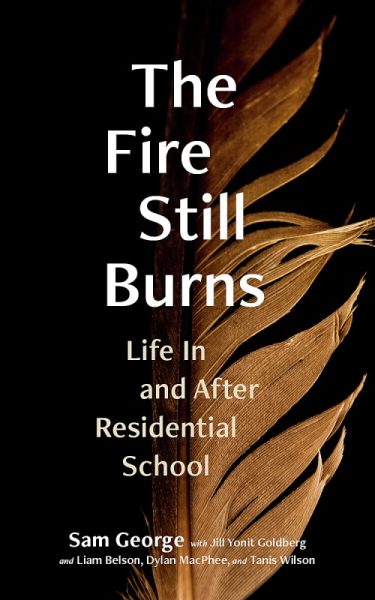
The Fire Still Burns: Life In and After Residential School
Review By Vanessa Mitchell
January 10, 2024
BC Studies no. 220 Winter 2023/24 | p. 123-124
The Fire Still Burns is a compelling read about Sam George’s personal experiences as a residential school survivor. The story moves seamlessly from one chapter to the next, bringing the reader alongside Sam’s chronology of perseverance and resurgence. Sam’s story not only echoes intergenerational trauma but what is clear is that the fundamental intent of Sam telling his story in this manner is to inspire a path toward healing.
From the onset, Sam’s dedication, “For all those who didn’t make it,” hits you right to your core. As the daughter of a residential school survivor and the first generation in my family to not attend residential school, Sam’s story is deeply personal and pierces my heart. Although The Fire Still Burns is a recounting of Sam’s story, his telling honors all the children who did not survive the colonial policies underpinning Canada’s residential school system as he unabashedly unveils his lived and living experiences of enduring residential school. Through his storytelling healing is interwoven in the words he shares, as the reader can almost feel how his story allows passage for traumatic memories to release their haunting grip on the storyteller’s soul.
Sam does not hold back: his story reveals all. His unwavering truth that he had the unmistakable characteristics of being “fully institutionalized” (68) by the time he entered prison because of the time spent in residential school, where he was conditioned to hide his emotions deep inside, is painful. Through profound vulnerability, Sam invites the reader into the messiness of healing work by sharing the horrific long-lasting effects of trauma and suffocated emotions upon a human being, particularly when it begins in childhood. His story clearly outlines for the reader exactly how Canada’s colonial policies were created to dehumanize and eradicate Indigenous peoples through acts of genocide and, failing that, sought to transition from the educational system of residential schools straight into the criminal justice system[1].
Sam’s journey reveals the power of being vulnerable and taking the first step; he discovered he was not alone in his trauma and suffering and could release the insidious grip of ‘shame and isolation’[2]. Although Sam says he “learned how to survive” (106), he has clearly moved from merely surviving to thriving and living his life with his eyes and heart wide open. By openly sharing his living experiences in this way, Sam models what it means to truly walk with humility and shows others healing is possible.
The Fire Still Burns is not a voyeuristic tale: it demands an active role from the reader. The Reader’s Guide section that is integrated at the end of this book is an important addition as it places responsibility on the reader to move beyond witnessing Sam’s story into critical reflection and, dare I say, action. As Sam makes clear, this story is not a colonial history of the past that Indigenous Peoples need ‘to just get over’[3]: it is an ongoing and ever-present colonial narrative. The inclusion of the Guide invites the reader to receive Sam’s story and further examine their own ability to ponder the question, “Now that (I) know about residential schools and their legacy, what do (I) do about it”[4] and how can we “contribute to the work of reconciliation” (117).
The Fire Still Burns is a formidable rendering of the survivance of the human spirit in residential schools, a book that should be read by Indigenous and non-Indigenous audiences as a testament to the power of healing.
[1] Truth and Reconciliation Commission of Canada, Honouring the Truth, Reconciling for the Future: Summary of the Final Report of the Truth and Reconciliation Commission of Canada (2015), 171.
[2] Matheson et al. Canada’s Colonial Genocide of Indigenous Peoples: A Review of the Psychosocial and Neurobiological Processes Linking Trauma and Intergenerational Outcomes. (International Journal of Environmental Research and Public Health 2022), 9.
[3] Truth and Reconciliation Commission of Canada, 310.
[4] Truth and Reconciliation Commission of Canada, 117.
REFERENCES
Matheson, Kimberly, Ann Seymour, Jyllenna Landry, Katelyn Ventura, Emily Arsenault, and Hymie Anisman. 2022. “Canada’s Colonial Genocide of Indigenous Peoples: A Review of the Psychosocial and Neurobiological Processes Linking Trauma and Intergenerational Outcomes” International Journal of Environmental Research and Public Health 19 (11): 1-28. https://doi.org/10.3390/ijerph19116455
Truth and Reconciliation Commission of Canada. 2015. Honouring the Truth, Reconciling for the Future: Summary of the Final Report of the Truth and Reconciliation Commission of Canada: Ottawa, ON, Canada.
Publication Information
George, Sam, with Jill Yonit Goldberg, Liam Belson, Dylan MacPhee, and Tanis Wilson. The Fire Still Burns: Life In and After Residential School. Vancouver, BC: University of British Columbia Press, Purich Books. 2022. 152 pp. $21.95 paper.
